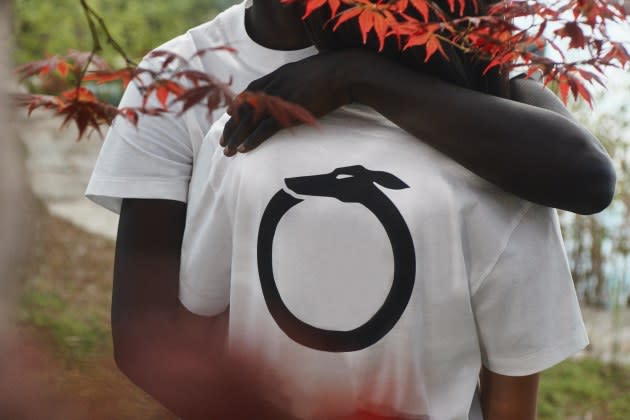Trussardi Sale Expected to Take Place in March

MILAN — The future of Trussardi is expected to be decided on March 7.
On that date, government-appointed commissioner Angelo Rodolfi will assign the assets of the troubled Trussardi brand to the interested party that will have presented the best industrial plan, said a market source, adding that the Italian Miroglio Group is the front-runner candidate to take over Trussardi.
More from WWD
“Yes, Miroglio has expressed its interest and is the company that has taken the project of restructuring Trussardi in the most serious way,” concurred a Milan-based source. “The group has a very significant industrial expertise and production capacity and can reorganize Trussardi’s manufacture without any problem or the need to depend on external help.”
Miroglio had no comment on the speculation.
The source believes that the Miroglio family and chief executive officer Alberto Racca, “a young executive who has already left his mark on the company with his innovative ideas,” realized that Trussardi can be “saved by following a different path, which doesn’t necessarily pass through the usual choice of a big-name creative director and fashion show, but through a focus on specific categories, emphasizing the value of the product in a competitive way, offering an elegant item to the customers of Trussardi, which still has a strong brand awareness.”
To wit, the source said that, for example, Trussardi’s fragrances, licensed to Angelini Beauty, are still a very solid business. “Miroglio has an expansive distribution network in Italy, so that once the industrial problems are solved, by giving dignity to the product, the brand will sell. To me, this deal makes a lot of sense.”
Another source said the takeover would also be an opportunity for Miroglio to give “a different and more modern configuration to the group. Racca has very clear ideas and is convinced this is an investment opportunity.”
Miroglio was founded in 1947 in Alba, in Italy’s Piedmont region, by Giuseppe Miroglio and controls nine brands that range from Elena Mirò and Caractère to Motivi, Oltre and Fiorella Rubino, among others. It has four production plants and 1,100 monobrand stores.
Italy’s independent asset management company QuattroR took a controlling stake in the Italian fashion brand in 2019, but last year, employees were put in “cassa integrazione,” or into a government-funded redundancy pay. Trussardi, through a range of sub-branches, is said to have an aggregated debt of around 70 million euros and last year filed for a restructuring plan with creditors that allowed it to continue to operate under the so-called process of “composition with creditors.”
Last March, the board of directors resigned, and CEO Sebastian Suhl, a former Valentino and Marc Jacobs executive, and the designers he had recruited as creative directors in May 2021, Serhat Işık and Benjamin A. Huseby, were all out. Işık and Huseby design their own label, the Berlin-based GmbH, launched in 2016, and are known for their commitment to inclusivity and sustainability and their socially engaged perspective.
Their designs created some buzz, attracting the likes of Dua Lipa, Kylie Jenner and Hailey Bieber, but production and distribution went through some hurdles, said a well-placed source.
“The pandemic weakened some companies more than others, especially those that were already suffering before COVID-19, which dealt the last blow,” said a source. “Brands that didn’t have the financial resources to support investments to relaunch never recovered and Trussardi was one of them, as it was in a delicate phase of relaunch with a complex positioning that was thwarted by the pandemic — even though mistakes were made, that can’t be denied. COVID-19 led to a serious market re-assessment.”
Trussardi’s home and children’s licenses are also said to be strong contributors to the business, which has long depended on leather goods. Trussardi was originally a glove-maker.
Suhl believed the designers’ talent would be able to reflect a young and more accessible Trussardi. He revisited the brand’s storied greyhound logo, first introduced in 1973, and slashed the previous complex set of multiple Trussardi brands to focus on the single signature label.
Trussardi did not have a creative director since Gaia Trussardi’s exit in 2018. She succeeded the likes of Umit Benan Sahin and Milan Vukmirovic.
Nicola Trussardi, who propelled the family’s business in the ’80 and ‘90s, died in 1999 in a car accident. His daughters, Gaia and Beatrice, are no longer involved in the company, while his son Tomaso became a strategic adviser of the house.
Suhl spearheaded the restructuring of Palazzo Trussardi, located close to the storied La Scala theater in Milan.
The building was first opened by Nicola Trussardi in 1996 as one of the first concept stores in the world, merging fashion retail with food, while also serving as an exhibition space for artists and architects.
The palazzo was entirely redesigned by the Berlin-based architecture studio Bplus.xyz together with Thorben Gröbel and housed two dining experiences in collaboration with Michelin-starred chef Giancarlo Perbellini.
Best of WWD
